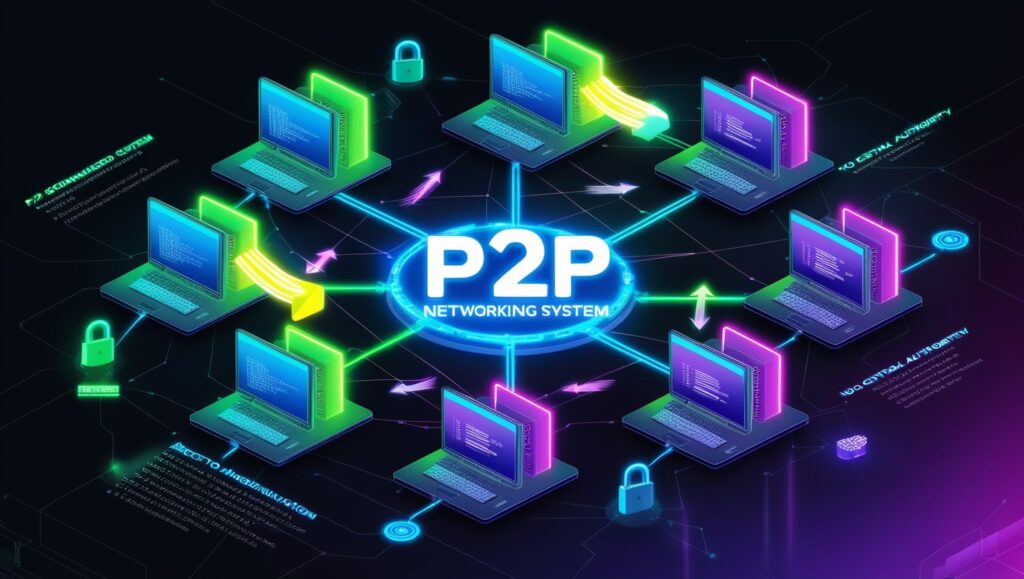Table of Contents
- Introduction to P2P Networking
- Defining P2P Networking
- How P2P Networking Operates
- Types of P2P Networks
- Common Uses of P2P Networking
- Benefits of P2P Networks
- Challenges and Limitations
- The Future Outlook of P2P Networking
- Conclusion
- FAQs

Introduction to P2P Networking
Peer-to-Peer (P2P) networking has revolutionized how information is shared across digital platforms. But what is P2P networking, and why has it gained such significance? This beginner-friendly guide will explain the essentials of P2P networking, providing clarity on its operation, applications, and potential.
Defining P2P Networking
P2P networking is a decentralized network model where each participant, known as a peer, has equivalent capabilities and responsibilities. Unlike conventional client-server models that rely on centralized servers to handle data, P2P networks distribute data and resources among all participants. This model supports greater resilience and flexibility.
How P2P Networking Operates
In P2P networks, data and tasks are shared directly between peers without intermediaries. Each connected device acts as both a client and a server. Here’s an overview of how these networks function:
Data Sharing: Information is split into smaller segments and dispersed among multiple peers.
Direct Communication: Peers connect directly to share and receive data portions, speeding up the distribution process.
Redundancy: If one peer goes offline, data can still be accessed through other peers, enhancing reliability.
Notable P2P Protocols
BitTorrent: A popular protocol for sharing large files by dividing them into smaller segments.
Gnutella: An early protocol that allowed decentralized file sharing among users.
Types of P2P Networks
Understanding the different forms of P2P networks provides insight into their various structures and use cases. The main types include:
- Pure P2P Networks
These networks operate without any central authority. All nodes share equal status and manage data exchange autonomously.
- Hybrid P2P Networks
A hybrid model blends decentralized and centralized components. For instance, a central server might assist with peer discovery while data transfers occur directly between peers.
- Structured vs. Unstructured P2P Networks
Structured: These networks follow a specific design for data retrieval, such as Distributed Hash Tables (DHTs).
Unstructured: They do not follow a fixed architecture, making data location less efficient but easier to set up.

Common Uses of P2P Networking
P2P networks extend beyond simple file sharing. Here are some common applications:
File Distribution: Services like BitTorrent enable the sharing of large files efficiently.
Blockchain and Decentralized Finance (DeFi): P2P technology is integral to blockchain, facilitating secure and transparent transactions.
P2P Communication Tools: Applications such as video conferencing tools leverage P2P for direct communication.
Media Streaming: Certain streaming platforms use P2P for distributing content seamlessly.
Benefits of P2P Networks
P2P networking has gained traction due to its numerous benefits:
- Decentralization
There is no single point of failure, making P2P networks more robust against downtime.
- Cost Efficiency
These networks reduce the need for central servers, cutting down infrastructure costs.
- Scalability
As more peers join the network, its capacity can expand, enhancing data distribution and performance.
- Enhanced Resource Utilization
The computing power of each peer contributes to the overall network, optimizing resource usage.
Challenges and Limitations
Despite their advantages, P2P networks also face certain challenges:
- Security Risks
P2P networks can be targeted by malicious users who distribute harmful content or malware.
- Data Authenticity
Without a central authority, ensuring data integrity can be difficult.
- Legal Issues
Unauthorized file sharing through P2P networks has led to legal challenges related to copyright infringement.
The Future Outlook of P2P Networking
P2P networking continues to evolve, particularly with the integration of blockchain and advanced cryptographic technologies. These developments make P2P systems more secure and scalable. As industries shift towards decentralization, P2P technology is likely to become even more prevalent, supporting innovation and expanding possibilities for data exchange.
Conclusion
P2P networking represents a shift towards more decentralized and resilient data-sharing methods. While it comes with challenges that need to be addressed, its benefits make it a vital technology in the modern digital landscape. A clear understanding of P2P networks helps individuals and businesses leverage its potential to drive innovation and efficiency.
FAQs
- How secure is P2P networking?
P2P networks can be secure, but additional measures are necessary to protect against potential vulnerabilities. - What types of P2P networks exist?
Common types include pure P2P, hybrid P2P, and structured versus unstructured networks. - Which industries use P2P networking?
P2P technology is widely used in file sharing, decentralized finance, streaming, and communication platforms. - What is the main difference between P2P and client-server models?
P2P networks distribute tasks among peers, whereas client-server models rely on a central server for managing data and resources.
